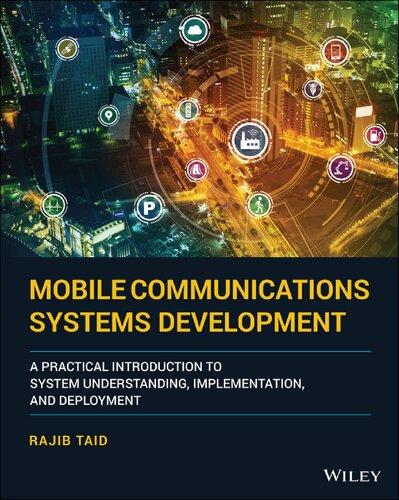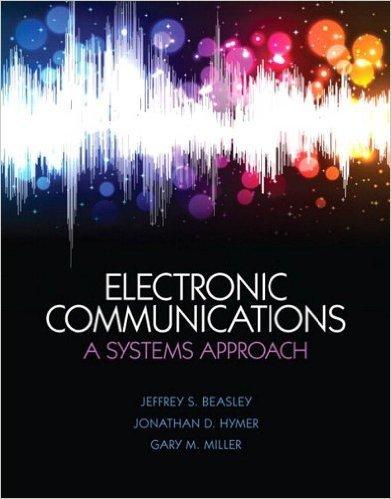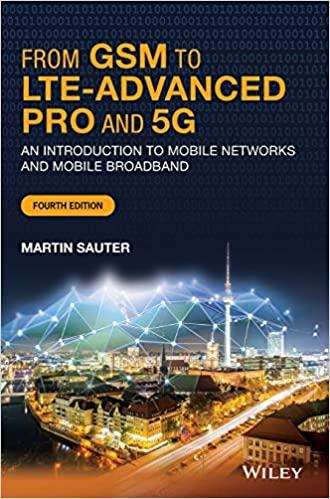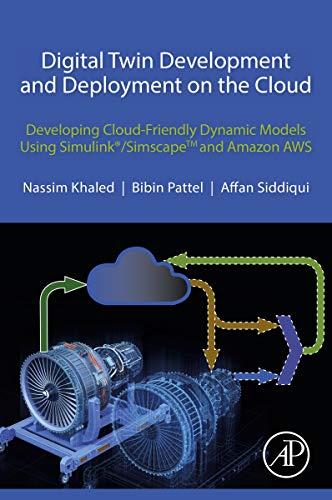Mobile Communications Systems Development
A Practical Introduction to System Understanding, Implementation, and Deployment
Rajib Taid
This edition first published 2021 © 2021 John Wiley & Sons Ltd
All rights reserved. No part of this publication may be reproduced, stored in a retrieval system, or transmitted, in any form or by any means, electronic, mechanical, photocopying, recording, or otherwise, except as permitted by law. Advice on how to obtain permission to reuse material from this title is available at http://www.wiley.com/go/permissions.
The right of Rajib Taid to be identified as the author of this work has been asserted in accordance with law.
Registered Offices
John Wiley & Sons, Inc., 111 River Street, Hoboken, NJ 07030, USA
John Wiley & Sons Ltd, The Atrium, Southern Gate, Chichester, West Sussex, PO19 8SQ, UK
Editorial Office
The Atrium, Southern Gate, Chichester, West Sussex, PO19 8SQ, UK
For details of our global editorial offices, customer services, and more information about Wiley products, visit us at www.wiley.com.
Wiley also publishes its books in a variety of electronic formats and by print‐on‐demand. Some content that appears in standard print versions of this book may not be available in other formats.
Limit of Liability/Disclaimer of Warranty
While the publisher and authors have used their best efforts in preparing this work, they make no representations or warranties with respect to the accuracy or completeness of the contents of this work and specifically disclaim all warranties, including without limitation any implied warranties of merchantability or fitness for a particular purpose. No warranty may be created or extended by sales representatives, written sales materials or promotional statements for this work. The fact that an organization, website, or product is referred to in this work as a citation and/or potential source of further information does not mean that the publisher and authors endorse the information or services the organization, website, or product may provide or recommendations it may make. This work is sold with the understanding that the publisher is not engaged in rendering professional services. The advice and strategies contained herein may not be suitable for your situation. You should consult with a specialist where appropriate. Further, readers should be aware that websites listed in this work may have changed or disappeared between when this work was written and when it is read. Neither the publisher nor authors shall be liable for any loss of profit or any other commercial damages, including but not limited to special, incidental, consequential, or other damages.
Library of Congress Cataloging‐in‐Publication Data applied for
ISBN 9781119778684 (Hardback)
Cover Design: Wiley
Cover Image: © Metamorworks/Shutterstock, Cnythzl/iStock/Getty Images
Set in 9.5/12.5pt STIXTwoText by SPi Global, Pondicherry, India
All the opinions, except the granted copyrighted materials being used, expressed in this book are author’s own, from personal experiences and does not represent either from the past or present employer.
Designations used by companies to distinguish their products are often claimed as trademarks. All brand names and product names used in this book are trade names, service marks, trademarks or registered trademarks of their respective owners. The publisher is not associated with any product or vendor mentioned in this book.
Contents
About the Author xiv
Preface xv
Acknowledgments xviii
List of Abbreviations xix
1 Introduction 1
Part I Network Architectures, Standardization, Protocols, and Functions 3
2 Network Architectures, Standardizations Process 5
2.1 Network Elements and Basic Networks Architectures 5
2.1.1 GSM (2G) Network Architecture 6
2.1.2 General Packet Radio Service (GPRS-2.5G) Network Architecture 7
2.1.3 Universal Mobile Telecommunications System (3G) Network Architecture 7
2.1.4 LTE (4G) Network Architecture 8
2.1.5 GSM, UMTS, LTE, and 5G Network Elements: A Comparison 9
2.1.6 Circuit Switched (CS) vs Packet Switched (PS) 9
2.2 Mobile Communication Network Domains 10
2.2.1 AN Domain 10
2.2.2 Core Network (CN) Domain 11
2.2.3 Network Domains and Its Elements 11
2.2.4 Example: End-to-End Mobile Network Information Flow 12
2.2.5 Example: GSM MO Call 13
2.3 Mobile Communications Systems Evolutions 14
2.3.1 Evolutions of Air Interface 14
2.3.2 Evolutions of 3GPP Networks Architectures 16
2.4 Mobile Communications Network System Engineering 19
2.4.1 Mobility Management 19
2.4.2 Air Interface Management 20
2.4.3 Subscribers and Services Management 20
2.4.4 Security Management 20
2.4.5 Network Maintenance 20
2.5 Standardizations of Mobile Communications Networks 21
2.5.1 3rd Generation Partnership Project (3GPP) 21
2.5.2 3GPP Working Groups 21
2.5.3 3GPP Technical Specification and Technical Report 22
2.5.4 Stages of a 3GPP Technical Specification 22
2.5.5 Release Number of 3GPP Technical Specification 22
2.5.6 3GPP Technical Specification Numbering Nomenclature 23
2.5.7 Vocabulary of 3GPP Specifications 24
2.5.8 Examples in a 3GPP Technical Specification 24
2.5.9 Standardization of Technical Specifications by 3GPP 24
2.5.10 Scope of 3GPP Technical Specification (TS) 24
2.5.11 3GPP TS for General Description of a Protocol Layer 25
2.5.12 3GPP TS Drafting Rules: Deriving Requirements 25
2.5.13 Download 3GPP Technical Specifications 25
2.5.14 3GPP Change Requests 26
2.5.15 Learnings from 3GPP Meetings TDocs 26
2.6 3GPP Releases and Its Features 26 Chapter Summary 27
3 Protocols, Interfaces, and Architectures 29
3.1 Protocol Interface and Its Stack 29
3.1.1 Physical Interface 30
3.1.2 Logical Interface 30
3.1.3 Logical Interfaces’ Names and Their Protocol Stack 33
3.1.4 Examples of Logical Interface and Its Protocol Layers 35
3.2 Classifications of Protocol Layers 36
3.2.1 Control Plane or Signaling Protocols 36
3.2.2 User Plane Protocols 38
3.3 Grouping of UMTS, LTE, and 5G Air Interface Protocol Layers 39
3.3.1 Access Stratum (AS): UMTS UE – UTRAN; LTE UE – E-UTRAN;5G UE - NG-RAN 39
3.3.2 Non-Access Stratum: UMTS UE – CN, LTE UE – EPC; 5G UE-Core 41
3.4 Initialization of a Logical Interface 42
3.5 Protocol Layer Termination 43
3.6 Protocol Sublayers 43
3.7 Protocol Conversion 44
3.8 Working Model of a 3GPP Protocol Layer: Services and Functions 45
3.9 General Protocol Model Between RAN and CN (UMTS, LTE, 5G) 46
3.10 Multiple Transport Networks, Protocols, and Physical Layer Interfaces 47
3.11 How to Identify and Understand Protocol Architectures 49
3.11.1 Identifying a Logical Interface, Protocol Stack, and Its Layers 49
3.11.2 Identification of Technical Requirements Using Interface Name 51
3.12 Protocol Layer Procedures over CN Interfaces 51
3.12.1 Similar Functions and Procedures over the CN Interfaces 52
3.12.2 Specific Functions and Procedures over the CN Interfaces 53 Chapter Summary 54
4 Encoding and Decoding of Messages 55
4.1 Description and Encoding/Decoding of Air Interface Messages 55
4.1.1 Encoding/Decoding: Air Interface Layer 3 Messages 56
4.1.2 Encoding/Decoding: LTE and 5G NR Layer 2: RLC Protocol 60
4.1.3 Encoding/Decoding: LTE and 5G NR Layer 2: MAC Protocol 60
4.1.4 CSN.1 Encoding/Decoding: GPRS Layer 2 Protocol (RLC/MAC) 60
4.1.5 ASN.1 Encoding/Decoding: UMTS, LTE, and 5G NR Layer 3 Protocol 61
4.1.6 Direct/Indirect Encoding Method 62
4.1.7 Segmented Messages over the Air Interface 63
4.1.8 Piggybacking a Signaling Message 63
4.2 Encoding/Decoding of Signaling Messages: RAN and CN 64 Chapter Summary 65
5 Network Elements: Identities and Its Addressing 67
5.1 Network Elements and Their Identities 67
5.2 Permanent Identities 68
5.3 Temporary Identities Assigned by CN 69
5.3.1 GSM System Temporary Identities 69
5.3.2 GPRS System Temporary Identities 69
5.3.3 LTE/EPS System Temporary Identities 70
5.4 Temporary Identities Assigned by RAN: RNTI 72
5.5 Usages of Network Identities 73
5.6 Native and Mapped Network Identities 73
5.7 LTE UE Application Protocol Identity 75 Chapter Summary 76
6 Interworking and Interoperations of Mobile Communications Networks 77
6.1 Requirements and Types of Interworking 77
6.2 Interworking Through Enhanced Network Elements 78
6.2.1 Interworking for Voice Call Through IMS: VoLTE 79
6.2.1.1 IP Multimedia Subsystem (IMS) 80
6.2.1.2 UE Registration and Authentication 81
6.2.2 Interworking for VoLTE Call Through LTE/EPS: SRVCC 83
6.2.3 Interworking for Voice Call Through LTE/EPS: CSFB 85
6.3 Interworking Through Legacy Network Elements 88
6.4 Interworking Between LTE/EPS and 5G Systems 89
6.5 Interoperations of Networks: LTE/EPS Roaming 90
6.5.1 Roaming Through Interoperations of Enhanced Networks Elements 90
6.5.2 Roaming Through Interoperations of Legacy Networks Elements 92
6.6 UE Mode of Operation 92
6.7 Function of E-UTRAN in a VoLTE Call 95 Chapter Summary 95
7 Load Balancing and Network Sharing 97
7.1 Core Network Elements Load Balancing 97
7.1.1 Identification of NAS Node: NRI and Its Source 99
7.1.2 NAS Node Selection Function 99
7.2 Network Sharing 102
7.2.1 GSM/GPRS/LTE RAN Sharing Through MOCN Feature 103
7.2.2 5G NG‐RAN Sharing Through MOCN Feature (Release 16) 109 Chapter Summary 110
8 Packets Encapsulations and Their Routing 111
8.1 User Data Packets Encapsulations 111
8.1.1 Packets Encapsulations at the CN and RAN 112
8.1.1.1 GPRS Tunneling Protocol ( GTP) 112
8.1.1.2 GTP Functions 112
8.1.1.3 GTP User Plane PDU: G-PDU 113
8.1.1.4 GTP Control Plane PDU 114
8.1.1.5 Example: GTP and Packet Encapsulations at LTE EPC 115
8.1.2 Packet Encapsulations over Air Interface 115
8.2 IP Packet Routing in Mobile Communications Networks 116
8.3 IP Header Compression and Decompression 117
Chapter Summary 119
9 Security Features in Mobile Communications Networks 121
9.1 A Brief on the Security Architecture: Features and Mechanisms 121
9.2 Security Features and Its Mechanisms 123
9.3 GSM Security Procedures 126
9.4 UMTS, LTE, and 5G: AS and NAS Layer Security Procedures 127
9.5
Security Contexts 130
9.6 Security Interworking 130 Chapter Summary 132
Part II Operations and Maintenances 133
10 Alarms and Faults Managements 135
10.1 Network Elements Alarm and Its Classifications 135
10.2 Sources of Abnormal Events and Alarms 136
10.3 Identifying Sources of Alarms from 3GPP TSs 136
10.3.1 Abnormal Conditions 136
10.3.2 Protocol Layer Error Handling 137
10.3.3 Abnormal Conditions Due to Local Errors 138
10.4 Design and Implementation of an Alarm Management System 138
10.4.1 Design and Components of an Alarm 139
10.4.2 Alarm Application Programming Interfaces (APIs) 139
10.4.3 Alarm Database 139
10.5 Alarm Due to Protocol Error 140
10.5.1 Sample Protocol Error Alarm Description 142
10.6 Alarm Due to Abnormal Conditions 142
10.6.1 Normal Scenario 143
10.6.2 Abnormal Scenario 143
10.6.3 Sample Alarm Description 144
10.6.4 Sample Alarm Generation 145
10.6.5 Sample Protocol Error Alarm Generation 145
10.7 How to Troubleshoot Protocol Error Using the Alarm Data 146 Chapter Summary 146
11 Performance Measurements and Optimizations of Mobile Communications Networks 147
11.1 Counters for Performance Measurements and Optimizations 147
11.2 Performance and Optimizations Management System 149
11.3 Key Performance Indicator (KPI) 150
11.3.1 What Is a KPI? 150
11.3.2 KPI Domains 150
11.3.3 KPI for Signaling or Control Plane 152
11.3.4 KPI for User or Data Plane 153
11.3.5 KPI Categories 154
11.3.6 KPI Evaluation Steps 155
11.3.7 Troubleshooting and Improving KPI 156
11.3.8 Components of a KPI Definition 157 Chapter Summary 157
12 Troubleshooting of Mobile Communications Networks Issues 159
12.1 Air Interface-Related Issues 159
12.1.1 Drive Test, Data Collection, and Its Analysis 160
12.2 Debugging Issues with IP-Based Logical Interface 160
12.2.1 IP Protocol Analyzer 161
12.2.2 Network/Application Throughput Issue 161
12.2.3 Switch Port Mirroring 161
12.3 Conformance Testing Issues 162
12.3.1 Example: Mobile Device (MS)/User Equipment (UE) Conformance Test 163
12.3.2 Example: Location Area Update Request 163
12.4 Interoperability Testing (IOT) Issues 164
12.5 Interworking Issues 165
12.6 Importance of Log/Traces and Its Collections 166
12.7 Steps for Troubleshooting 167 Chapter Summary 170
Part III
Mobile Communications Systems Development 171
13 Core Software Development Fundamentals 173
13.1 A Brief on Software Development Fundamentals 173
13.1.1 Requirements Phase 174
13.1.2 Design 174
13.1.3 Implementation 175
13.1.4 Integration and Testing 175
13.1.5 Operation and Maintenance 175
13.2 Hardware Platforms: Embedded System, Linux Versus PC 176
13.2.1 System Development Using Embedded System Board 176
13.2.2 System Development Using Multicore Hardware Platform 177
13.2.2.1 What Is a Core? 178
13.2.2.2 Network Element Development Using Multicore Platform 178
13.2.2.3 Runtime Choices of Multicore Processor 178
13.2.2.4 Software Programming Model for Multicore Processor 179
13.3 Selecting Software Platforms and Features 179
13.3.1 Selecting Available Data/Logical Structures 180
13.3.1.1 Advanced Data Structures 180
13.3.1.2 How Data Structure Affects the Application’s Performance 180
13.3.2 Selecting an Operating System Services/Facilities 181
13.3.2.1 Advance Features of Operating System: IPC 181
13.4 Software Simulators for a Mobile Communications Network 184
13.5 Software Root Causes and Their Debugging 185
13.5.1 Incorrect Usages of Software Library System Calls/APIs 185
13.5.2 Incorrect Usages of System Resources 185
13.5.3 Bad Software Programming Practices 185
13.6 Static Code Analysis of Software 186
13.7 Software Architecture and Software Organization 186
13.8 System and Software Requirements Analysis 188
13.9 Software Quality: Reliability, Scalability, and Availability 188
13.9.1 Reliability 188
13.9.2 Scalability 188
13.9.3 Availability 188 Chapter Summary 189
14 Protocols, Protocol Stack Developments, and Testing 191
14.1 Components of a 3GPP Protocol TS 191
14.2 3GPP Protocol Layer Structured Procedure Description 193
14.3 Protocol Layer Communications 194
14.3.1 Layer-to-Layer Communication Using Service Primitives 195
14.3.2 Layer-to-Layer Communication: SAP 196
14.3.3 Peer-to-Peer Layer Communication: PDU and Service Data Unit (SDU) 197
14.3.4 Types of PDU 198
14.3.5 Formats of PDU 198
14.4 Air Interface Message Format: Signaling Layer 3 198
14.4.1 A Brief on the Air Interface Layer 3 Protocol Stack 198
14.4.2 Classification of Layer 3 Messages 199
14.4.3 Layer 3 Protocol Header: Signaling Message Format 200
14.4.4 Layer 3 Protocol Header: Protocol Discriminator 202
14.4.5 Layer 3 Protocol Header: GSM, GPRS Skip Indicator 202
14.4.6 Layer 3 Protocol Header: GSM, GPRS Transaction Identifier 204
14.4.7 Layer 3 Protocol Header: LTE/EPS Bearer Identity 204
14.4.8 Layer 3 Protocol Header: 5GSM PDU Session Identity 204
14.4.9 Constructing a Layer 3 Message 204
14.4.10 Security Protected LTE/EPS and 5G NAS Layer MM Messages 205
14.4.11 Layer 3 Protocol Layer’s Message Dump 207
14.5 Air Interface Message Format: Layer 2 207
14.6 RAN – CN Signaling Messages 208
14.6.1 Protocol Layer Elementary Procedure 208
14.6.2 Types and Classes of EPs 210
14.6.3 EPs Code 210
14.6.4 Criticality of IE 211
14.6.5 Types of Protocol Errors and Its Handling 211
14.6.6 Choices of Triggering Message 212
14.6.7 Message Type 212
14.6.8 Message Description 212
14.6.9 Example: LTE/EPS S1 Interface: S1 Setup Procedure 213
14.7 Modes Operation of a Protocol Layer 213
14.8 Example of a Protocol Primitive and PDU Definition 215
14.9 Example of a Protocol Layer Frame Header Definition 216
14.10 Examples of System Parameters 216
14.11 Examples of Protocol Information Elements and Its Identifier 217
14.12 3GPP Release Specific Changes Implementation 218
14.13 Examples of Protocol Messages Types 219
14.14 Protocol Layer Timer Handling 219
14.15 Protocol Layer Development Using State Machine 222
14.16 Protocol Layer Development Using Message Passing 224
14.17 Protocol Layer Data and its Types 225
14.18 Protocol Layer Control and Configuration 226
14.19 Protocol Context Information 227
14.20 Protocol Layer Message Padding 228
14.21 Device Driver Development 229
14.22 Guidelines for Protocol Stack/Layer Development 230
14.23 Software Profiling, Tools and Performance Improvement 231
14.24 Protocol Stack Testing and Validation 231 Chapter Summary 233
15 Deriving Requirements Specifications from a TS 235
15.1 3GPP Protocol Layer Procedures 235
15.1.1 LTE UE Mode of Operation Requirements 236
15.1.2 LTE UE ATTACH Procedure Requirements 236
15.1.3 LTE UE DETACH Procedure Requirements 237
15.1.4 LTE UE Tracking Area Update Procedure Requirements 237
15.2 3GPP System Feature Development Requirements 238
15.2.1 Identification of System/Network Elements Interfaces Changes 238
15.2.2 Identifications of Impacts on Performance 238
15.2.3 Identifications of Impacts on Feature Management 239
15.2.4 Identification of Interworking Requirements with Existing Features 239
15.2.5 Charging and Accounting Aspects 239
15.3 Example Feature: Radio Access Network Sharing 239
15.3.1 Effects on Network Elements 239
15.3.2 Effects on Logical Interfaces 240
15.3.3 Selection of Core Network Operator: PLMN Id 241
15.4 Example: Interworking/Interoperations 242
15.4.1 Circuit-Switched Fall Back (CSFB) 242
15.4.2 Single Radio Voice Call Continuity (SRVCC) 243
15.5 3GPP System Feature and High-Level Design 244 Chapter Summary 245
Part IV 5G System and Network 247
16 5G Network: Use Cases and Architecture 249
16.1 5G System (5GS) Use Cases 249
16.1.1 Enablers and Key Principles of 5GS Use Cases 250
16.1.2 Other Enablers in 5G System 253
16.2 Support of Legacy Services by 5G System 253
16.3 5G System Network Architecture 254
16.3.1 3GPP Access Architecture 254
16.3.2 Non-3GPP Access Architecture 256
16.4 5G System NG–RAN/gNB Logical Architecture 256
16.5 5GC System Architecture Elements 259
16.6 5G System Deployment Solutions 260
16.6.1 E–UTRA–NR Dual Connectivity (EN–DC) for NSA Deployment 261
16.7 5G System and LTE/EPS Interworking 265
16.7.1 RAN-Level Interworking 265
16.7.2 Core Network (CN) Level Interworking: N26 Interface 265
16.7.2.1 Single Registration Mode with N26 Interface 266
16.7.2.2 Dual Registration Mode: Without N26 Interface 266
16.8 5G System Native and Mapped Network Identities 268
16.8.1 Mobility Area Identifiers 268
16.8.2 UE/Subscriber Permanent Identifiers 269
16.8.3 Core Network Identifiers 269
16.8.4 RAN Identifiers 269
16.8.5 Core Network Temporary Identities 270
16.9 5G System Network Slicing 270
16.9.1 Identities for a Network Slice 271
16.9.2 Impacts of Network Slicing Feature 273
16.10 Management and Orchestration (MANO) of 5G Network 278
16.11 5G System Security 280
16.11.1 UE Authentication Frameworks and Methods 280
16.11.2 Primary Authentication and Secondary Authentication 282
16.11.3 Key Hierarchy and Authentication Vector 282
16.11.4 New Security Requirements in 5G System 283
16.11.5 Subscriber Identities/Privacy Protection 286 Chapter Summary 287
17 Introduction to GSM, UMTS, and LTE Systems Air Interface 289
17.1 Air Interfaces Protocol Architectures 289
17.2 Protocol Sublayers 290
17.3 Control Plane and User Plane Protocols 291
17.4 Protocols Domains Classifications 291
17.5 Access Stratum and Non-access Stratum 291
17.6 Message Formats 292
17.7 Security Over the Air Interface 293
17.8 Piggybacking for Reduction of Signaling Overhead 293
17.8.1 Examples Piggybacking of Signaling Messages 293 Chapter Summary 294
18 5G NR Air Interface: Control Plane Protocols 295
18.1 NR Control Plane Protocol Layers 295
18.2 Session Management (5G SM) Layer 296
18.2.1 Procedures of 5G SM Layer 297
18.2.2 PDU Session Types 298
18.2.3 PDU Session Service Continuity (SSC) 299
18.2.4 PDU Sessions for Network Slices 300
18.2.5 Session Management (SM) Layer States 301
18.3 Quality of Service (5G QoS) 301
18.3.1 LTE/EPS QoS Model: EPS Bearer 301
18.3.2 5GS QoS Model: QoS Flow 301
18.3.3 GTP-U Plane Tunnel for PDU Session 302
18.3.4 Service Data Flow and PCC Rule 302
18.3.5 Binding of Service Data Flow 303
18.3.6 QoS Profile and QFI 303
18.3.7 QoS Rule and QRI 305
18.3.8 Mapping QoS Flow to Data Radio Bearer 305
18.3.9 Downlink Data Flow Through GTP-U Plane Tunnels 307
18.4 Mobility Management (5G MM) Layer 308
18.4.1 Mobility Area Concepts and Identifiers 308
18.4.2 Requirements of Mobility Management Functions 313
18.4.3 Functions and Procedures of 5G MM Layer 314
18.4.4 Mobility Management Layer States 315
18.4.5 Connection Management (CM) and Service Request 316
18.4.6 Mobility Pattern of UE 317
18.5 RRC Layer 317
18.5.1 Functions and Procedures of RRC Layer 317
18.5.2 System Information (SI) Broadcast 318
18.5.3 RRC Layer States 319
18.5.4 RRC INACTIVE State 320
18.5.5 Mobility of UE 326
18.5.5.1 UE Mobility in RRC IDLE State 326
18.5.5.2 UE Mobility in RRC INACTIVE State 326
18.5.5.3 UE Mobility in RRC CONNECTED State 327
18.5.6 Admission Control 332 Chapter Summary 334
19 5G NR Air Interface 335
19.1 NR User Plane Protocol Layers 335
19.2 SDAP Layer 336
19.3 PDCP Layer 336
19.4 RLC Layer 340
19.5 MAC Layer 342
19.5.1 Functions and Procedures 342
19.5.2 Scheduling Procedure 344
19.5.3 Random Access Procedure 346
19.5.4 Error Correction Through HARQ Procedure 351
19.5.5 Buffer Status Reporting (BSR) Procedure 352
19.5.6 Scheduling Request (SR) Procedure 353
19.5.7 Low Latency in the NR Due to Configured Scheduling 353
19.5.8 MAC Layer PDU and Header Structures 354
19.5.9 How MAC Layer Ensures Low‐Latency Requirements 356
19.5.10 Channel Structures in NR 357
19.6 Physical Layer 359
19.6.1 Principles of Transmissions and Its Directions 360
19.6.2 Physical Layer Functions, Procedures, and Services 360
19.6.3 OFDM Symbol 363
19.6.4 NR Frame and Slot Format 364
19.6.4.1 Subcarrier Spacing (SCS)/Numerologies (μ) 364
19.6.4.2 Slots per NR Frame and Subframe 364
19.6.4.3 Slot Formats in TDD Mode 366
19.6.4.4 Dynamic TDD 367
19.6.5 Resource Grid and Resource Block 368
19.6.5.1 Control Resource Set (CORESET) 369
19.6.5.2 Common Resource Blocks (CRB) 370
19.6.5.3 Physical Resource Block (PRB) 370
19.6.5.4 Virtual Resource Block (VRB) 370
19.6.5.5 Interleaved and Non‐interleaved PRB Allocation 370
19.6.5.6 PRB Bundling and VRB to PRB Mapping 371
19.6.5.7 Reference Point “A” 371
19.6.6 Channel and Transmission Bandwidths 371
19.6.7 Bandwidth Part (BWP) 373
19.6.7.1 Types of BWP 374
19.6.7.2 BWP Configuration 375
19.6.7.3 BWP Switching and Associated Delay 376
19.6.8 NR Resource Allocations 377
19.6.8.1 Frequency Domain Resource Allocation for FDD Transmission 377
19.6.8.2 Time‐Domain Resources Allocation for FDD Transmission 380
19.6.8.3 Time‐Domain Resources Allocation for TDD 383
19.6.9 Transport Channels and Their Processing Chain 384
19.6.9.1 CRC Calculation and its Attachment to a Transport Block 385
19.6.9.2 Code Block Segmentation 385
19.6.9.3 Channel Encoding with LDPC 386
19.6.9.4 Rate Matching and Concatenation 387
19.6.9.5 Multiplexing of UL‐SCH Data and Uplink Control Information 388
19.6.9.6 LDPC Encoding Examples 388
19.6.10 Physical Channels and Their Processing Chain 390
19.6.10.1 Physical Channels 390
19.6.10.2 Channel Mappings 391
19.6.10.3 Multiple Physical Antenna Transmissions 392
19.6.10.4 Physical Channel Processing Chain 395
19.6.10.5 Physical Downlink Control Channel (PDCCH) 397
19.6.10.6 Physical Uplink Control Channel (PUCCH) and Information (UCI) 404
19.6.11 Code Block Group‐Based Transmission and Reception 405
19.6.12 Physical Signals 409
19.6.12.1 Reference Signals Transmitted as Part of Physical Channels 410
19.6.12.2 Sounding Reference Signals 412
19.6.13 Downlink Synchronization 414
19.6.14 Millimeter Wave Transmission, Beamforming, and Its Management 419
19.6.15 Cell‐Level Radio Link Monitoring (RLM) 424
19.6.16 RRM Measurements for UE Mobility 426
19.6.16.1 RRM Measurement Signals and Their Quantities 426
19.6.16.2 RRM Measurements Framework 427
19.6.16.3 Overall RRM Process 429
19.6.17 Channel State Information (CSI) 430
19.6.18 Modulation and Coding Schemes (MCSs) 433
19.6.19 Link Adaptation Procedure 434
19.6.20 Random Access (RACH) Procedure 435
19.6.21 NR Radio Resources Management (RRM) Procedure 439
19.6.22 UE Transmit Power Control 444
19.6.22.1 Types of Power Control Procedure in NR 444
19.6.22.2 UE Transmit Power Determination Procedure in NR 445
19.6.23 Effect of Physical Layer on Data Throughputs 445 Chapter Summary 446
20 5G Core Network Architecture 447
20.1 Control Plane and User Plane Separation – CUPS 447
20.1.1 Impacts of CUPS Feature 448
20.1.2 CUPS in the LTE/EPC Network 449
20.1.3 CUPS Feature in 5G Core Network 450
20.2 Service-Based Architecture (SBA) 452
20.2.1 Network Functions and Its Instances 453
20.2.2 Network Functions (NFs) and Their Services Interfaces 454
20.2.3 5G System Architecture with NF 456
20.2.4 Network Functions and Their Services and Operations 457
20.2.5 Network Functions Services Framework 458
20.2.6 Services API for Network Functions 462
20.2.7 Network Function Selection 468
20.3 Network Function Virtualization (NFV) 469 Chapter Summary 472
21 5G System: Low-level Design 473
21.1 Design of 5GC Service Interface and Its Operations 473
21.2 Design of 5GC NF Service Interface Using UML and C++ Class Diagram 474
21.3 Usages of C++ Standard Template Library (STL) 475
21.4 Software Architecture for 5G System 476
21.4.1 NG-RAN Logical Nodes Software Architecture 476
21.4.2 5GC Software Architecture 479
21.5 Data Types Used in 5GC SBI Communications 479 Chapter Summary 491
22 3GPP Release 16 and Beyond 493
22.1 5GS Enhancements as Part of Release 16 493
22.2 5GS New Features as Part of Release 16 494
22.3 3GPP Release 17 496 Chapter Summary 496
Appendix 497
References 503
Index 507
About the Author
Rajib Taid graduated with a Bachelor of Computer Science and Engineering degree from Jorhat Engineering College, Assam, India. He began his career as an Engineer (Telemetry) at GAIL, a public‐sector entity. Rajib worked there for four years in the area of design and development of application software systems for a gas pipeline. Then, he joined a Gurgaon (Haryana, India)‐based communication software services major as well as product development MNC, Aricent Technologies (www.aricent.com), formerly known as Hughes Software Systems, where he started working as a software developer in the area of mobile communications. He worked there for 12 years, both as an individual contributor and in a lead role, primarily developing software in Radio Access Network, and Core Network domains. The author also visited Australia, the USA and the UAE for onsite assignments. He hails from the Jorhat district of Assam, India.
In 2013, Rajib left the mobile telecommunication software development domain and joined BCPL, a public‐sector entity at Dibrugarh, close to his hometown in Assam. Currently, the author specializes in IT and enterprise business information systems management.
Rajib Taid is also a member of the Department Management Committee, as an industry expert, for the Department of Computer Science and Engineering in the Dibrugarh University Institute of Engineering and Technology, Assam, India.
Preface
Today, we are using at least one smartphone for our day-to-day voice, data communications, online gaming, and transaction services. To enable these services, we are also aware of the different mobile communications technologies that are available around us today, such as GSM, GPRS/EDGE, 3G, 4G, and 5G being the latest communication buzzword. If you are wondering and, sometimes, scouring the web regarding how a mobile communications system is designed, developed, tested, and deployed, then this book is for you! This is an introductory jump-start, foundational, and comprehensive book offering several key concepts encompassing the various practical aspects for the design and development of a mobile communications system and its various entities/ elements based on the GSM, GPRS, UMTS (3G), LTE (4G), and 5G technologies. Note that this book is not about the developments of Mobile Application (apps) software that is intended and developed for a specific purpose/ requirement.
The content of this book is specially tailored for the rookie computer science or electronics and communications engineering graduate engineer who has just passed out of college, or even for a lesser experienced person looking for an opportunity to work in the mobile telecommunications space through re-skilling. It starts with the various mobile communications network architectures, identification of a particular network element, the concerned 3GPP standard specifications, various protocols/stacks, as well as the development platforms such as UNIX, and multicore computing. In this book, the reader will also find the troubleshooting of any issue arising out of post-deployment and operation of a mobile communication network element. This book also introduces the “multicore processor” computing platform that is available around us and is the current buzzword in different areas of technologies, be it the desktop or mobile handset. Mobile telecommunications system development using an embedded system platform is also briefly covered.
A mobile communication network works and communicates based on the standard technical specifications related to a particular mobile communication technology such as the GSM, GPRS, UMTS, LTE, and 5G system. Also, mobile communication standard technical specifications are large in number and can be bewildering to a new learner. Reading and its implementation, through computer code, of the contents of a GSM/ GPRS/UMTS/LTE/5G technical specification requires a substantial amount of effort, especially the Layer 1 and Layer 2 protocols. From a technical specification, one would come to know what to and when to transmit or receive information. But what is not available in the 3GPP technical specifications is the how to implement part as it is implementation dependent. This book was written keeping these facts in mind, so that students can learn the practical, real-world mobile telecommunications domain subject areas and equip themselves while in college, before starting a career in the relevant domains. To make the contents easier to understand, necessary figures, tables, and sample codes are provided to illustrate the underlying concepts. The illustrative figures and concepts are sometimes general in nature, i.e. applicable for GSM/GPRS or UMTS/LTE/5G system, or all of them, and sometimes a straight copy from the concerned 3GPP technical specification with due permissions.
This book is an overview and may not contain exhaustive descriptions or information on various individual components and protocols of a mobile communications system based on the GSM, GPRS, UMTS, LTE, and 5G system. The book attempts to provide the reader with an overall background of the various aspects of an end-toend system development based on the available mobile communication technologies and systems. This book reflects the author’s 12 years of experience with a full lifecycle of software research and development, deployment, testing, operation, and maintenance in the areas of mobile communication, Radio Access Network (RAN), and Core Network (CN) domain deployed across the available platforms, including satellite-based mobile communications systems.
Who should use this book?
Mobile Communications System Development: An Introduction to Practical Approach for Systems Understanding, Implementation, and Deployment is primarily for students who have just graduated in either computer science or electronics and communications discipline and is looking for an exciting career in the mobile communications domain. It is also appropriate for students currently studying in the above-mentioned disciplines and looking for project work assignments as a part of the academic curriculum in the mobile communication domain. An experienced person from another software domain can also go through this book for a career reboot into the mobile communication domain.
How to use this book?
Mobile communications systems protocol layers, their functions and procedures, and other related information, such as referring to figures, being presented may be brief in nature. For further details about the underlying protocols along with the materials being presented here, the concerned 3GPP technical specification(s) on its website (www.3gpp.org) [1] must be referred to while going through a chapter of this book. The concerned 3GPP technical specifications numbers are mentioned in the References section of the book. The reader is advised to refer to the mentioned 3GPP technical specification and the section number for complete information on the described protocol functions and procedures. Familiarity with the 3GPP website is also important as the reader will be required to visit it quite often to refer to its technical specifications.
Structure of this book
Overall, this book is divided into four parts, each containing several chapters. Each part begins with introductory objectives and also mentions the purposes of each chapter under it. Each chapter is followed by its summary. Also, the book starts with an introductory chapter that provides a brief description of the career opportunities offered by mobile communications systems and network ecosystems.
Part I Introduction
This part contains eight chapters containing the background and introductory aspects and areas of mobile communications systems and networks based on GSM, GPRS, UMTS, LTE, and 5G systems. The materials presented in this part are general in nature but applicable across the mobile communications systems and networks. Even if a reader is starting a career in the LTE or 5G system and network, as a developer or O&M person, one has to know the major key concepts from the legacy GSM/UMTS networks as well.
Part II Operation and Maintenance
This part contains three chapters covering various aspects and areas of the troubleshooting and resolution of mobile communications systems and network issues.
Part III Development of Mobile Communications Systems
This part contains four chapters covering various aspects and areas of the development of mobile communications systems protocol stack and layers based on the 3GPP standards and their technical specifications. This part also describes hardware platforms to be used for the development of mobile communications systems network elements.
Part IV 5G System and Network
This part contains seven chapters covering various aspects and areas of a 5G system and network based on its first Release 15 as standardized by the 3GPP. Also, an overview of the enhancements made into the existing features of the 3GPP Release 15 and the addition of new services or capabilities which have been added as part of the 3GPP Release 16 and Release 17 are covered in this part.
Dibrugarh, Assam, India Rajib Taid
Acknowledgments
I thank my dear friends and colleagues for offering encouragement and valuable comments during the preparation of this book. During my time in Hughes Software Systems (now known as Aricent, located in Gurgaon, India), I had the opportunity to work with very smart and talented people who were generous in sharing their knowledge and experience. Special thanks also go to Mr. Sumit Kasera (AVP, Technology at Aricent, Gurgaon, India) for his valuable feedback on this book.
I would also like to thank 3GPP for permitting me to reproduce a few snapshots from the concerned 3GPP technical specifications.
I would also like to thank and appreciate John Wiley & Sons Ltd., UK, and its acquisition, editorial, production, and publishing staff, for their continuous support and cooperation during the entire process of this book’s production.
List of Abbreviations
Here are the glossaries of some of the terms used in this book for ready references. For a complete list of terms and their definitions, please refer to the 3GPP TR 21.905 [24].
3G/4G/5G 3rd /4th/5th Generation
3GPP Third Generation Partnership Project
5GS 5G System
5G-GUTI 5G Globally Unique Temporary Identifier
5G-S-TMSI 5G S-Temporary Mobile Subscription Identifier
5GC 5G Core Network
A-bis A-bis Interface
ACK Acknowledged Mode
AKA Authentication and Key Agreement
AMF Access and Mobility Management Function
AMP Asymmetric Multicore Processing
AP Application Protocol
APN Access Point Name
AF Application Function
ARFCN Absolute radio-frequency channel number
ARQ Automatic Repeat Request
AS Access Stratum
ASN.1 Abstract Syntax Notation One
AuC Authentication Center
AUSF Authentication Server Function
BCF Base Control Function
BCH Broadcast Channel (Transport)
BCCH Broadcast Control Channel (Logical)
BICN Bearer-Independent Core Network BICN
BIST Built-in self-test (BIST)
BS Base station
BSC Base station controller
BSN Block Sequence Number
BSS Base Station Subsystem
BSSGP Base Station System GPRS Protocol
BSSMAP Base Station Subsystem Mobile Application Part
BSP Board Support Package
BSR Buffer Status Report
List of Abbreviations xx
BTS Base Transceiver Station
BWP Bandwidth Part
C-RNTI Cell Radio-Network Temporary Identifier
CBG Code block group
CBGFI CBG flush indicator
CC Call Control
CCE Control Channel Element
CCCH/DCCH Common/Dedicated Control Channel
CC/CM Call Control/Connection Management
CM Connection Management
CN Core Network
CORESET Control Resource Set
CRB Common Resource Block
CRC Cyclic redundancy check
CRI
CSI-RS Resource Indicator
CSI Channel State Information
CSI-RS Channel State Information Reference Signal
CS-RNTI Configured scheduling RNTI
CSI-RSRP CSI Reference Signal Received Power
CSI-RSRQ CSI Reference Signal Received Quality
CSI-SINR CSI Signal-to-Noise and Interference Ratio
CSFB Circuit-switched Fall-back
CP Cyclic Prefix
CPS Call per second
CQI Channel Quality Indication
CS Circuit-switched
CSN Concrete Syntax Notation
DCI Downlink control information
DL-SCH/UL-SCH Downlink/Uplink Shared Channel
DM-RS Demodulation reference signals
DN Data Network
DNN Data Network Name
DRB Data Radio Bearer
DSP Digital Signal Processor
DTAP Direct Transfer Application Part
DTCH Dedicated Traffic Channel
eMBB Enhanced Mobile Broadband
EAP Extensible Authentication Protocol
ECM Evolved Packet System Connection Management
EDGE Enhanced Data for Global Evolution
EGPRS Enhanced General Packet Radio Service
eNodeB Evolved NodeB
EIR Equipment Identity Register
EMM Evolved Packet System Mobility Management
EN-DC E-UTRA NR Dual-Connectivity
EPC Evolved Packet Core
EPS Evolved Packet System
ESM Evolved Packet System Session Management
ETSI European Telecommunications Standards Institute
E-UTRA Evolved-UMTS Terrestrial Radio Access
E-UTRAN Evolved-UMTS Terrestrial Radio Access Network
FDD Frequency Division Duplex
FR Frame Relay
FR1 Frequency Range 1 (5G)
FR2 Frequency Range 2 (5G)
FTP File Transfer Protocol
FW Framework
GBR Guaranteed Bit Rate
GERAN GPRS Edge Radio Access Network
GGSN Gateway GPRS Support Node
GMSC Gateway Mobile Switching Center
gNB/gNodeB 5G Base Station
GPRS General Packet Radio Service
GSM Global System for Mobile Communication
GUAMI Globally Unique AMF ID
GUMMEI Globally Unique MME Identifier
HARQ Hybrid Automatic Repeat Request
HLR/HSS Home Location Register/Home Subscriber Server
HS-DSG High Speed Downlink Shared Channel
HSDPA High-Speed Downlink Packet Access
HSPA High-Speed Packet Access
HSUPA High-Speed Uplink Packet Access
IAB Integrated Access and Backhaul
IDNNS Intra Domain NAS Node Selector
IE Information Element
IEI Information Element Identifier
IMS IP Multimedia Subsystem
IMSI International Mobile Subscriber Identity
INT-RNTI Interruption RNTI
IOT Inter-operability Testing
IP Internet Protocol
IPC Inter Process Communication
IPH IP Header Compression
ISI Inter Symbol Interference
ISR Idle State Signaling Reduction
IWF Interworking Function
KAMSE LTE Key Access Security Management Entity
KPI Key Performance Identifier
L1....Ln Layer 1....n
LAI Location Area Identification
LCID Logical Channel Identifier
LDPC Low Density Parity Check
LLC Logical Link Control
LI Layer Indicator
List of Abbreviations
LSB Least Significant Bit
LTE Long-term Evolution
mMTC Massive Machine Type Communications
mIoT Massive Internet of Things
MAC Medium Access Control
MANO Management and Orchestration
MCC Mobile Country Code
MCS Modulation and coding scheme
MIB Master Information Block
MIMO Multiple-Input Multiple-Output
MM Mobility Management
MME Mobility Management Entity
MMEC MME Code
MMS Multimedia messaging service
MN Master Node
MNC Mobile Network Code
MOC Mobile-originated voice call
MOCN Multi-operator Core Network
MS Mobile station
MSB Most Significant Bit
MSC Mobile Switching Center
MSC-S MSC Server
MSIN Mobile Subscriber Identification Number
MU-MIMO Multi-User MIMO
N3IWF Non-3GPP Inter-working Function
NACK Negative Acknowledgment
NAS Non-access Stratum
NEF Network Exposure Function
NF Network Function
NFV Network Functions Virtualization
NGAP Next Generation Application Protocol
NG-RAN Next Generation Radio Access Network
Non-GBR Non-Guaranteed Bit Rate
NNSF NAS Node Selection Function
NRF Network Repository Function
NSA Non-Standalone
NR New Radio
NRF Network Repository Function
NSSAI Network Slice Selection Assistance Information
NSSF Network Slice Selection Function
NSAPI Network Service Access Point Identifier
NSS Network Subsystem
OFDM Orthogonal Frequency Division Multiplexing
OFDMA Orthogonal Frequency Division Multiplexing Access
O&M Operation and Maintenance
PBCH Physical Broadcast Channel
PCH Paging Channel
PCF Policy Control Function
PCO Protocol Configuration Options
PCRF Policy Charging and Restriction Function
PCU Packet Control Unit
PCFICH Physical Control Format Indicator Channel
PDCCH Physical Downlink Control Channel
PDCP Packet Data Convergence Protocol
PDSCH Physical Downlink Shared Channel
PD Protocol Discriminator
PDSCH/PUSCH Physical Downlink/Uplink Shared Channel
PDN Packet Data Network
PDU Protocol Data Unit
PDP Packet Data Protocol
PEI Permanent Equipment Identifier
PER Packet Error Rate
PLMN Public Land Mobile Network
PFC Packet Flow Context
PGW Packet Data Network Gateway
PHICH Physical HARQ Indication Channel
PMI Precoding-Matrix Indicator
POST Power-on self-test
PRACH Physical Random-Access Channel
PRB Physical Radio Block
P-RNTI Paging RNTI
PS Packet Switched
PSS Primary Synchronization Signal
PSTN Public Switched Telephone Network
PTI Procedure Transaction Identity
PTRS Phase-tracking Reference Signal
PUCCH Physical Uplink Control Channel
PUSCH Physical Uplink Shared Channel
QAM Quadrature Amplitude Modulation
QCI QoS Class Identifier
QFI QoS Flow ID
QoS Quality of Service
QPSK Quadrature Phase Shift Keying
RAB Radio Access Bearer
RAI Routing Area Identification
RAC Routeing Area Code
RAN Radio Access Network
RA-RNTI Random Access RNTI
RACH Random Access Channel
RAT Radio Access Technology
RB Resource Block
RE Resource Element
RBG Resource Block Group
RF Radio Frequency
List of Abbreviations
RI Rank Indicator
RAU Routing Area Update
REG Resource Element Group
RLC Radio Link Control
RF Radio Frequency
RIV Resource Indication Value
RNA RAN-based Notification Area
RNAU RAN-based Notification Area Update
RNS Radio Network Subsystem
RNC Radio Network Controller
RNL Radio Network Layer
RNTI Radio Network Temporary Identifier
RoHC Robust Header Compression
RR Radio Resource
RRC Radio Resource Control
RS Reference Signal
RSRP Reference Signal Received Power
RSRQ Reference Signal Received Quality
RRM Radio Resource Management
RTOS Real-Time Operating System
S1-AP S1 Application Protocol
SA Standalone Mode
SAP Service Access Point
SAPI Service Access Point Identifier
SBA Service-based Architecture
SBI Service-based Interface
SCP Service Communication Proxy
SCTP Stream Control Transmission Protocol
SDAP Service Data Application Protocol
SDCCH Standalone Dedicated Control Channel
SDN Software Defined Networking
SDU Service Data Unit
SD Slice Differentiator
SEAF Security Anchor Functionality
SEPP Security Edge Protection Proxy
SFN System Frame Number
SFI-RNTI Slot Format Indication RNTI
SGSN Serving GPRS Support Node
SIB System Information Block
SLA Service-Level Agreement
SMP Symmetric Multicore Processing
S-GW Serving Gateway
SI Skip Indicator/System Information
SM Session Management
SMS Short Messaging Service
SMF Session Management Function
SN RLC Layer PDU Sequence Number
SN Secondary Node
SNDCP Subnetwork Dependent Convergence Protocol
S-NSSAI Single Network Slice Selection Assistance Information
SNPN Standalone Non-Public Network
SSC Session and Service Continuity
SST Slice/Service Type
SPS Semi-persistent Scheduling
SR Scheduling Request
SRVCC Single Radio Voice Call Continuity
SRB Signaling radio bearers
SRS Sounding reference signal
SSB Synchronization Signal Block
SSS Secondary Synchronization Signal
SS Supplementary Services
SS/PBCH Synchronization Signal Physical Broadcast Channel
SS-RSRP SS Reference Signal Received Power
SS-RSRQ SS Reference Signal Received Quality
SS-SINR SS Signal-to-Noise and Interference Ratio
STL Standard Template Library
SU-MIMO Single-User MIMO
SUCI Subscription Concealed Identifier
SUPI Subscription Permanent Identifier
TAC Tracking Area Code
TAU Tracking Area Update
TCH Traffic Channel
TCP/IP Transmission Control Protocol/Internet Protocol
TDD Time Division Duplex
TI Transaction Identifier
TFT Traffic Flow Template
TNL Transport Network Layer
TPC Transmit Power Control
TRX Trans-receiver
TS Timeslot
TTI Transmission Time Interval
UCI Uplink Control Information
UDM Unified Data Management
UDP User Datagram Protocol
UDR Unified Data Repository
UE User Equipment
Um GSM Air Interface
UML Unified Modeling Language
UMTS Universal Mobile Telecommunication System
Uu UMTS/LTE Air Interface
UPF User Plane Function
UTRAN UMTS terrestrial radio access network UMTS
URLLC Ultra Reliable and Low Latency Communications
UUID Universally Unique Identifier
List of Abbreviations
VLR Visitor Location Register
VoLTE Voice over LTE
VRB Virtual Resource Block
WCDMA Wideband Code Division Multiple Access (UMTS)
Xn-C Xn-Control plane
Xn-U Xn-User plane
XnAP Xn Application Protocol
Career Opportunities in Mobile Communications Networks Space
You see, wire telegraph is a kind of a very, very long cat. You pull his tail in New York; and his head is meowing in Los Angeles. Do you understand this? And radio operates exactly the same way: you send signals here, they receive them there. The only difference is that there is no cat.
Source: Albert Einstein
Gone are the days when mobile phones were considered a luxury; today, it is among our daily necessities. Mobile communications have evolved quickly and revolutionized the way we communicate and have brought people around the globe closer than ever before. At the same time, the mobile telecom industry has witnessed an explosive growth rate over the past many years, offering a wide range of services and products.
The latest trend is the availability of multitasking smartphones and various apps for different services and capabilities for our day-to-day needs. The combination of smartphones and Apps is enabling mobile broadband services to everyone, everywhere, and anytime on the go. This is leading to a growing demand for smartphones along with manifold increase in Internet traffic. The legacy mobile communications network standards such as Global System for Mobile Communication (GSM) (2G), General Packet Radio Service (GPRS) (2.5G), Universal Mobile Telecommunication System (UMTS) (3G), Long-Term Evolution (LTE) (4G), and the emerging and latest buzzword 5G, along with the growth in the number of mobile subscribers, have created a gap between the demand and supply of skilled mobile communications professionals.
The mobile communications industry is a key driver and offers immense employment opportunities. The advent of the 5G system and network is expected to create and offer more opportunities for various professionals and business owners. Communications solution service providers, network installers, original equipment manufacturers (OEMs), and communications software solution services provider firms are demanding skilled and experienced professionals. In the mobile communications space alone, career opportunities exist across these different verticals and areas. Some of these career opportunities are shown in Figure 1.1.
The career opportunity areas shown in Figure 1.1 are at a very high level only. Each of the areas shown spans across multiple systems and subsystems. Opportunities exist at an entry-level or experienced professional level for various job roles such as software developer and maintenance, team leader, project manager, system architect and engineering, site engineer, network engineer, network operation and maintenance, and so on.
Mobile communications systems and networks are built based on open technical standards, covering a wide spectrum of knowledge areas as illustrated in Figure 1.1. The knowledge areas are spread across the different system engineering areas of mobile communications systems and networks. This book attempts to cover some of those knowledge areas from a practical point of view, so that one can be self-equipped to start a career in the mobile communications domain.
Career Opportunities in Mobile communications Systems and Networks Space
Operations and Maintenances Areas
-Installation and Commissioning
-Drive/Field Test, RF, Network Planning, and Optimization
- Maintenance and Sustenance of Mobile Telecom Network
-Equipment/Site Engineers for Installation and Uptime
-Customer Experience Management
-Root Cause Analysis of Failures and Remedial Actions
-Network Monitoring
-KPI and SLA Management
-Preventive & Corrective Maintenances of Active and Passive Elements
-Traffic Provisioning & Management
-Alarm/Fault Management
-Process Compliances for Audit/Statutory Requirements
System R&D Areas
-Consulting and System Engineering for Different Business Verticals
-System /Software Architecture and Design
-Protocol Layer/Stack Design and Development
-Testing and Validation, Including Inter-operability Test, of Telecom Standards and Conformances
-Telecom Standard Specification and Interface Development
-Deep Packet Inspection (DPI)
-Operations and Support Systems (OSS)
-Business Support System (BSS)
-Billing
-Alarm/Fault Management
Figure 1.1 Career opportunities in the mobile communications space.











